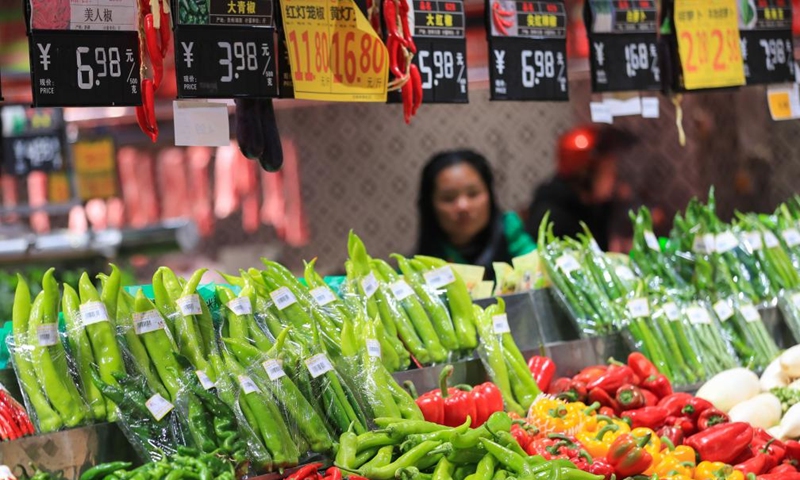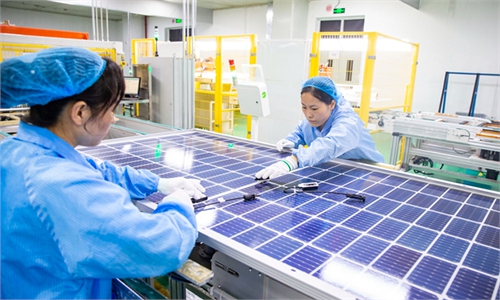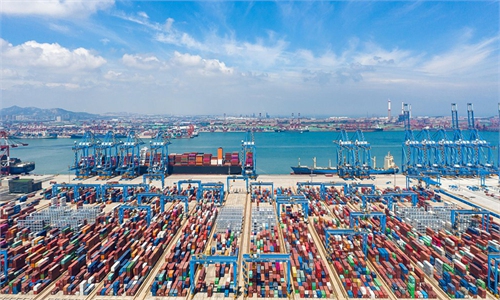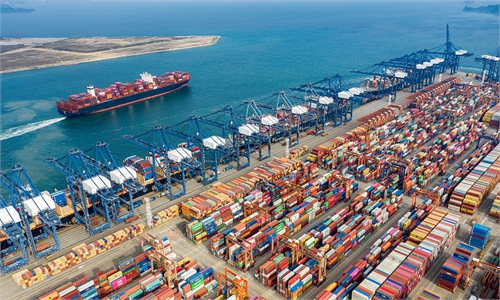Chinese provinces step up policy support to unlock Q2 consumption potential after strong Q1 start

A customer shops at a supermarket in Congjiang County, southwest China's Guizhou Province, March 9, 2024. Photo: Xinhua
Provincial-level economic figures for the first quarter are being released across China, with many regions delivering a solid start to the year despite a complex global economic backdrop. Local governments have pledged to further prioritize efforts to boost domestic demand and accelerate the impact of supportive policies.
Experts said on Wednesday that in the face of mounting pressure from US tariff policies, China is well-prepared and the economy is expected to maintain its steady recovery momentum into the second quarter.
East China's Shandong Province, one of the country's economic powerhouses, on Wednesday reported a 6 percent GDP growth rate in the first quarter, marking a strong start to the year. The province's GDP reached 2.35 trillion yuan ($321 billion) in the first three months. This 6 percent growth rate was 0.6 percentage points higher than the national average of 5.4 percent, underscoring Shandong's role as a key driver among China's major economies, local government data showed.
Also off to a strong start this year is Central China's Hubei Province, which saw its first-quarter GDP grow by 6.3 percent year-on-year, 0.9 percentage points above the national average and the province's fastest growth pace in nearly 12 quarters. East China's Anhui Province also posted a 6.2 percent growth, its best quarterly growth rate in the past three years.
Central China's Hunan Province's GDP grew by 5.4 percent year-on-year in the first quarter, with notable progress in boosting domestic demand. The province's retail sales reached 513.6 billion yuan, up 5.6 percent from a year earlier, according to local official data.
Local economies across the country achieved a steady and promising start to the year. Many provinces saw outstanding performances - with regions like Hubei and Anhui reporting GDP growth rates well above the national average, underscoring their strong economic vitality and growth potential, Wang Peng, an associate research fellow at the Beijing Academy of Social Sciences, told the Global Times on Wednesday.
Furthermore, economic structures continued to improve, with emerging industries such as high-tech manufacturing becoming key drivers of growth. The ongoing rollout of supportive policies also provided a solid foundation for sustained economic expansion, Wang said.
Meanwhile, many localities are swiftly outlining key priorities for the second quarter, with a clear focus on boosting domestic demand and accelerating the impact of policy measures.
Shanghai plans to roll out targeted initiatives to boost consumption, ensure the effective implementation of policies promoting the large-scale renewal of equipment and the trade-in of consumer goods, expand spending on services and exhibitions, promote inbound tourism, and create more integrated consumption scenarios that blend culture, commerce, tourism and sports.
Localities' push to boost domestic demand is revealing strong potential across multiple sectors. The services industry - especially modern services such as information transmission, software and IT - stands out as a key growth driver, Wang noted.
Emerging industries like new-energy vehicles and high-end equipment manufacturing are also poised for rapid expansion, fueled by technological innovation and growing market demand. At the same time, consumption upgrades in areas like green and smart spending are shaping up to be new engines of economic growth, Wang added.
In the second quarter, steep US tariff hikes are expected to hamper direct exports to the American market, dealing a serious blow to the global economic order. With the external environment growing increasingly complex and uncertain, sustaining the momentum of economic recovery is likely to face greater pressure, Wen Bin, chief economist at China Minsheng Bank, told the Global Times on Wednesday.
However, China has already put in place well-prepared contingency plans to navigate these headwinds, Wen said.
Since the launch of reform and opening-up, China's economy has weathered numerous storms - from the Asian and global financial crises to China-US trade frictions and the severe impact of the COVID-19 pandemic. Each time, the country has emerged stronger, gaining valuable experience in macroeconomic management, Sheng Laiyun, deputy head of the National Bureau of Statistics, told a press conference on April 16.
China will roll out additional policy measures as needed in response to changes in the external environment, Sheng said, adding that a well-equipped policy toolbox remains a key safeguard against external shocks and challenges.



